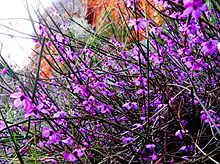| Tetratheca aphylla | |
|---|---|
 | |
| Flowering shrub | |
| Scientific classification | |
| Kingdom: | Plantae |
| Clade: | Tracheophytes |
| Clade: | Angiosperms |
| Clade: | Eudicots |
| Clade: | Rosids |
| Order: | Oxalidales |
| Family: | Elaeocarpaceae |
| Genus: | Tetratheca |
| Species: | T. aphylla |
| Binomial name | |
| Tetratheca aphylla F.Muell., 1882 | |
Tetratheca aphylla, also known as the Bungalbin Tetratheca, is a species of flowering plant in the quandong family that is endemic to Australia.
Subspecies
- Tetratheca aphylla subsp. aphylla
- Tetratheca aphylla subsp. megacarpa
Description
The species grows as an erect, spreading, leafless shrub to 60 cm in height. The flowers are pink or pink-purple, appearing from September to October.[2]
Distribution and habitat
The range of the species lies within the Coolgardie and Mallee IBRA bioregions of south-west Western Australia, where it occurs in the Helena Aurora Range, 50 km north-north-east of Koolyanobbing, and 80 km east of Newdegate. The plants grow in pockets of skeletal soil among banded iron formations, rock outcrops and debris, in shrubland.[2][1]
Conservation
The species is listed as Vulnerable under Australia's EPBC Act. The main potential threats are mining activities, inappropriate fire regimes and roadworks.[1]
References
- 1 2 3 "Approved Conservation Advice for Tetratheca aphylla (Bungalbin Tetratheca)" (PDF). Threatened Species. Department of the Environment, Australia. 2008. Retrieved 20 October 2021.
- 1 2 Amanda Spooner (2007). "Tetratheca aphylla F.Muell". Florabase. Department of Biodiversity, Conservation and Attractions, Western Australia. Retrieved 20 October 2021.
